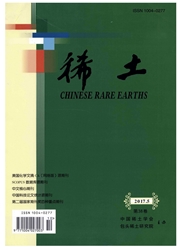

 中文摘要:
中文摘要:
[目的]为稀土农用拓展及环境污染防治提供策略。[方法]采用水培法培养大豆,待第3枚三出复叶展开后进行La和UV-B辐射处理。以前期试验确定的最适浓度LaCl3(20mg/L)溶液均匀喷洒大豆叶片,48 h后,放置于特定剂量的紫外灯下进行胁迫处理。UV-B设2个处理:T1(0.15 W/m^2)、T2(0.45 W/m^2),每天处理6 h(10:00-16:00),连续处理5 d,每天同一时间取同向、同叶位大豆幼苗叶片测定叶绿素(Ch1)、丙二醛(MDA)、H_2O_2膜脂脂肪酸、吲哚乙酸(IAA)和脱落酸(ABA)的含量。[结果]UV-B(T_1:0.15 W/m~2和T_2:0.45 W/m~2)辐射下,大豆幼苗叶绿素(Ch1)和吲哚乙酸(IAA)含量在胁迫期(1~5 d)逐渐下降,在恢复期(6-11 d)上升;丙二醛(MDA)和脱落酸(ABA)含量先增(1~5 d)后减(6~11 d)。20 mg/L La(Ⅲ)减缓了上述指标在胁迫期的下降/上升趋势,加快了恢复期的上升/下降速度。[结论]La(Ⅲ)对大豆幼苗膜脂过氧化和内源激素的调控能提高叶绿素和IAA含量,改善活性氧的新陈代谢,抑制膜脂过氧化作用,减少ABA积累,且对低剂量紫外辐射(T_1)的防护效果优于高剂量紫外辐射(T_2)。
 英文摘要:
英文摘要:
[ Objective] The aim was to provide strategies for development of rare earth and control of environmental pollution. [ Method] Responses of membrane lipid peroxidation and endogenous hormones of soybean seedlings to UV-B radiation and rare earth were studied through hydroponics in laboratory. [ Result] The results showed that under irradiation of UV-B( T1-0.15 W/m^2 and T2-0.45 W/m^2), chlorophyll and indole-3-acetic acid(IAA) contents firstly decreased during the stress phase (1 -5 d) and then increased during the restoration phase (6 -9 d) while contents of malonadialdehyde(MDA) and abscisic acid(ABA) gradually increased during the imposition of UV-B radiation (1 -5 d) and subsequently decreased during recovery from UV-B stress (6 -9 d) . With adding of La (III) with the concentration of 20 mg · L^-1 , the decline/dse trend of chlorophyll, IAA, MDA and ABA contents was slowed down during the stress period while the rise/decline speed was accelerated during the recovery period. [ Conclusion] It suggests that the regulation of La ( III ) on membrane lipid peroxidation and endogenous hormones could increase chlorophyll and IAA contents, improve the metabolism of reactive oxygen species ( ROS), inhibit membrane lipid peroxidation, decrease the accumulation amount of ABA and alleviate injury of UV-B radiation to soybean seedlings. Further, the protective potential of La ( III ) was better under low UV-B radiation than under high one.
 同期刊论文项目
同期刊论文项目
 同项目期刊论文
同项目期刊论文
 Subcellular location of horseradish peroxidase in horseradish leave treated with La(III), Ce(III) an
Subcellular location of horseradish peroxidase in horseradish leave treated with La(III), Ce(III) an Antioxidant capacity of flavonoid in soybean seedlings under the joint actions of rare earth element
Antioxidant capacity of flavonoid in soybean seedlings under the joint actions of rare earth element Effects of rare earth elements on the distribution of mineral elements and heavy metals in horseradi
Effects of rare earth elements on the distribution of mineral elements and heavy metals in horseradi 期刊信息
期刊信息
